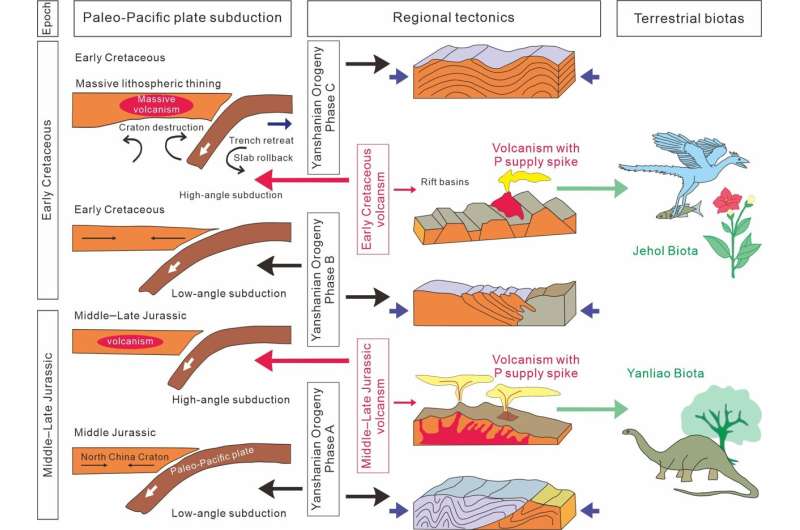This article has been reviewed according to Science X's editorial process and policies. Editors have highlighted the following attributes while ensuring the content's credibility:
fact-checked
trusted source
proofread
How volcanic phosphorus supply boosted the Jehol Biota in northern China

Have you ever heard of the Jehol Biota, a diverse assemblage of plants and animals during the Mesozoic Era that lived in what is now northern China? The Jehol Biota, which includes the earliest known flowering plants, feathered dinosaurs and early birds, had a high level of biodiversity and biomass compared to other contemporaneous lagerstätten.
But why was this area so rich in life during this period? Recent research suggests that the prosperity of this unique ecosystem was closely tied to the destruction of the North China Craton. The fascinating story of how the destruction of the craton led to the flourishing of the Jehol Biota has captivated scientists for years. A study published in Science Bulletin and conducted by a group of international researchers has discovered a crucial factor that may have contributed to the flourishing of the Jehol Biota during a time of upheaval: volcanic phosphorus (P).
During the Mesozoic Era, the North China Craton underwent a period of destruction that caused massive volcanic eruptions, spewing ash and lava across the landscape. As the volcanic products weathered over time, they released large amounts of an essential nutrient for life known as P into the soil and water. This allowed plants to grow more quickly and become more abundant, which in turn supported a thriving ecosystem of animals, from insects to dinosaurs.
Lead author of the study, Professor Yanjie Tang of the Institute of Geology and Geophysics, Chinese Academy of Sciences, said, "Our research shows that the flourishing of the terrestrial biotas in northern China during the Mesozoic Era was not just due to a fortuitous combination of factors, but was in fact a response to the unique geological conditions of the time."
By analyzing the volcanic-sedimentary sequences in northern China, researchers have traced the changes in P delivery, biological productivity and species abundance over time. They have found that there were episodic increases in P supply, which coincided with periods of high biological productivity and species abundance.
In addition, the younging trend of Jehol fossils is consistent with the migration of volcanism with increased volcanic P supply in northern China. These phenomena suggest that the elevated volcanic P supply from volcanic weathering to terrestrial ecosystems played a significant role in the Jehol Biota's success. The increased P supply was not a steady stream, however. Instead, it occurred in pulses, corresponding to the dynamics of Jehol Biota radiation.
Interestingly, this pattern of volcanic-biotic coupling was not unique to the Jehol Biota. Similar phenomena were observed in the preceding Yanliao Biota, which had relatively fewer fossils but still showed evidence of volcanic P supply. As the North China craton continued to be destroyed and volcanic activity increased, the supply of P grew, creating an environment more conducive to the high prosperity of the Jehol Biota.
Researchers are still working to understand the precise mechanisms involved in this process. One thing is clear, however: the Jehol and Yanliao biotas are a testament to the incredible complexity of life on Earth and the many factors that contribute to the evolution of different species.
The biotas serve as a reminder of the incredible diversity and resilience of life, and how it can adapt and thrive even in the face of dramatic environmental changes. By studying the link between craton destruction and biota development, researchers are gaining a better understanding of the intricate relationships between geology, climate, and biology that have shaped our planet over millions of years.
More information: Chao Ma et al, Volcanic phosphorus supply boosted Mesozoic terrestrial biotas in northern China, Science Bulletin (2023). DOI: 10.1016/j.scib.2023.05.022
Provided by Science China Press


















